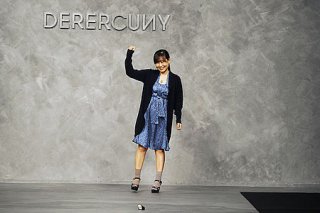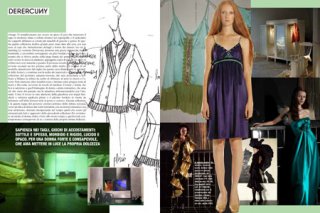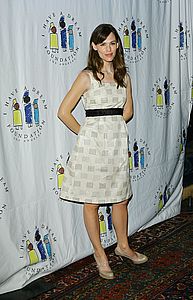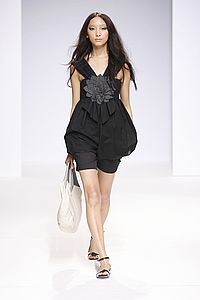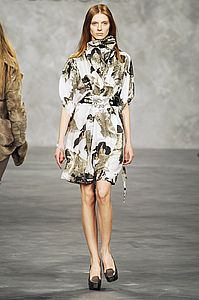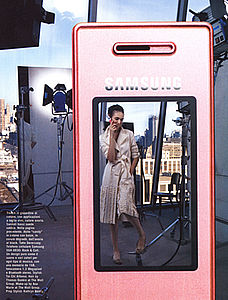Italy's Hot New Couturier
Has an Unfamiliar Ring
By RACHEL DODES and SUNGHA PARK
February 21, 2008
(wsj.com)
In a recent advertising spread in Italian Vogue, a model poses while the contents of her handbag -- including several cellphones -- spill into the street. A caption explains that she is wearing "tutto Derercuny."
Not quite "all Derercuny." There is Samsung in there, too. Unbeknownst to many followers of high fashion, Derercuny, a three-year-old Italian label that is garnering attention during this week's Milan fashion shows, is part of South Korea's sprawling Samsung Group. Best known for Samsung Electronics Co., the world's largest seller of televisions and second-largest seller of cellphones, the group also includes Cheil Industries Co., a huge textile and chemicals concern that owns Derercuny directly.
Derercuny's Korean-born designer, Mina Lee, who unveiled her latest collection Sunday during Milan fashion week, says the fit isn't as odd as it sounds. For Cheil, which posted $3.1 billion in sales last year, entering the notoriously unpredictable high-fashion business is part of a new strategy to diversify away from its entrenched bulk textiles business, where China and India have a competitive advantage, and from its more recent forays into moderately priced apparel. Instead, Cheil hopes to gain international cachet and realize higher profit margins by developing luxury brands.
Cheil, meanwhile, has begun capitalizing on Derercuny's high-end image, tapping Ms. Lee to work with a Korean design team on a small, made-in-Italy "capsule collection" for its mass-market Korean apparel chain Bean Pole last year. Since Derercuny represents Cheil's first investment in a designer label, Ms. Lee acknowledges that grappling with both stringent financial targets and corporate bureaucracy could "take away from the creative side." At the same time, having a deep-pocketed owner gives her a sense of security, she says. The company has promised to finance Derercuny for eight years, even if it is unprofitable, a significant commitment for an unproven label.
Retailers and fashion editors say Derercuny, which had $3 million in sales last year, is one of the most exciting new brands to emerge from Italy in the past several years. Ms. Lee creates garments that "are hyper-special, with a lot of detail," says Ken Downing, women's fashion director at Neiman Marcus, which has been carrying Ms. Lee's collection since 2006. Ms. Lee's signature details, such as intricate embroidery and pleating, are especially appealing right now, Mr. Downing says, because they are the type of special treatments that could entice shoppers to spend in an economic slowdown.
Still, Cheil's backing has been a double-edge sword for Derercuny. When people hear that Derercuny is owned by a Samsung company, they associate it with electronics and think that designs must involve "high tech and strange fabrics," says Ms. Lee, adding that she finds it "slightly annoying" having to always explain that her label manufactures everything in Italy, using European fabrics and that Derercuny has nothing to do with electronics.
Cheil contributes to the confusion by invoking the Samsung name outside South Korea to boost its own stature. For instance, it holds a competition every year to recognize Korean designers working in the world's fashion capitals. Known as the Samsung Fashion Design Fund, it has given $100,000 prizes to emerging designers such as Doo-ri Chung and Sang A Im-Propp.
For Samsung Electronics, an $85 billion behemoth, direct involvement with tiny Derercuny has been limited to an ad campaign in Italy and Derercuny-brand cellphone accessories.
To further diversify its fashion business, Cheil plans to open a Korean outpost of the prominent Milanese boutique 10 Corso Como next month. The store will likely carry Derercuny clothing, among other high-end brands.
Carla Sozzani, the owner of 10 Corso Como, says she initially was approached by Cheil executives, who invited her to Korea and gave her a tour of the new Samsung Museum of Art, with buildings designed by architects she admires, including Jean Nouvel. While in Seoul, she discovered that Korean women are "very elegant," she says. So when Cheil suggested opening a store together, "I said, 'Why not?' " recalls Ms. Sozzani. "I always try to bring other cultures to Milan, and now I am trying to bring a bit of Italy to Asia." Ms. Sozzani says she has no immediate plans to expand 10 Corso Como into other countries.
She says that Derercuny's "sweet, pretty dresses" are selling well at her Milan store.
Founded in 1954, Cheil was one of the first companies started by industrialist Lee Byung-chul, whose success building the Samsung Group of companies made him one of the richest men in Asia. Today, his son leads the Samsung Group, which contains 59 businesses with combined revenue of $160 billion. Cheil is a leading player in Korea's textile industry, but amid competition from developing nations, textiles account for only one-third of Cheil's revenue. Plastics, chemicals and electronic circuitry make up the rest.
In 2003, Cheil decided to make a move into high-end fashion, creating a division called Samsung Fashion. Cheil chose to use the Samsung brand name because Cheil "has no name value" outside Korea, says Jee-young Kim, senior manager of Cheil's global business planning team. The fashion group's priority was to identify a talented European designer and launch a luxury label from scratch.
Cheil executives read an article in the Korean press mentioning Ms. Lee, who had worked with Italian designer Luisa Beccaria as well as with European brands Fiorucci and Escada. Although the company wasn't initially seeking a Korean designer, "Mina felt like a better fit," says Hooda Soodi, the company's director of sales in Milan.
In 2003, Ms. Lee got to work on her new line, which she initially called Derer Cuny, a fictitious person's name that she says reflected "an ideal woman" without alluding to any particular nationality. (The company's public-relations firm later suggested that she combine the two words.) Her first collection, for the spring 2005 season, was unveiled in Milan. When retailers like Selfridges, the British department store, as well as boutiques in Japan and Italy, wrote orders totaling $200,000, Ms. Lee knew she was on the right track.
The following year, Derercuny generated more than $2 million in sales, from 35 retail clients in 15 countries, including Saks Fifth Avenue and Neiman Marcus. The brand also was cited as a hot emerging label in Italian Vogue.
To burnish its image in the U.S., where it now derives 27% of its sales, Derercuny has begun advertising in small U.S. publications and on Web sites like Style.com. But like most emerging fashion labels, Derercuny has yet to turn a profit. Cheil has invested $22 million in the brand so far, and says it will continue funding it, so long as Ms. Lee can break even by 2012. Despite having to modify her sales forecast for 2008 amid a weak dollar and a consumer slowdown, Ms. Lee says she is confident that she can hit profitability without changing her strategy of manufacturing her collection in Italy using only European fabrics. "Our objective is to remain a first-tier label," Ms. Lee says.
Has an Unfamiliar Ring
By RACHEL DODES and SUNGHA PARK
February 21, 2008
(wsj.com)
In a recent advertising spread in Italian Vogue, a model poses while the contents of her handbag -- including several cellphones -- spill into the street. A caption explains that she is wearing "tutto Derercuny."
Not quite "all Derercuny." There is Samsung in there, too. Unbeknownst to many followers of high fashion, Derercuny, a three-year-old Italian label that is garnering attention during this week's Milan fashion shows, is part of South Korea's sprawling Samsung Group. Best known for Samsung Electronics Co., the world's largest seller of televisions and second-largest seller of cellphones, the group also includes Cheil Industries Co., a huge textile and chemicals concern that owns Derercuny directly.
Derercuny's Korean-born designer, Mina Lee, who unveiled her latest collection Sunday during Milan fashion week, says the fit isn't as odd as it sounds. For Cheil, which posted $3.1 billion in sales last year, entering the notoriously unpredictable high-fashion business is part of a new strategy to diversify away from its entrenched bulk textiles business, where China and India have a competitive advantage, and from its more recent forays into moderately priced apparel. Instead, Cheil hopes to gain international cachet and realize higher profit margins by developing luxury brands.
Cheil, meanwhile, has begun capitalizing on Derercuny's high-end image, tapping Ms. Lee to work with a Korean design team on a small, made-in-Italy "capsule collection" for its mass-market Korean apparel chain Bean Pole last year. Since Derercuny represents Cheil's first investment in a designer label, Ms. Lee acknowledges that grappling with both stringent financial targets and corporate bureaucracy could "take away from the creative side." At the same time, having a deep-pocketed owner gives her a sense of security, she says. The company has promised to finance Derercuny for eight years, even if it is unprofitable, a significant commitment for an unproven label.
Retailers and fashion editors say Derercuny, which had $3 million in sales last year, is one of the most exciting new brands to emerge from Italy in the past several years. Ms. Lee creates garments that "are hyper-special, with a lot of detail," says Ken Downing, women's fashion director at Neiman Marcus, which has been carrying Ms. Lee's collection since 2006. Ms. Lee's signature details, such as intricate embroidery and pleating, are especially appealing right now, Mr. Downing says, because they are the type of special treatments that could entice shoppers to spend in an economic slowdown.
Still, Cheil's backing has been a double-edge sword for Derercuny. When people hear that Derercuny is owned by a Samsung company, they associate it with electronics and think that designs must involve "high tech and strange fabrics," says Ms. Lee, adding that she finds it "slightly annoying" having to always explain that her label manufactures everything in Italy, using European fabrics and that Derercuny has nothing to do with electronics.
Cheil contributes to the confusion by invoking the Samsung name outside South Korea to boost its own stature. For instance, it holds a competition every year to recognize Korean designers working in the world's fashion capitals. Known as the Samsung Fashion Design Fund, it has given $100,000 prizes to emerging designers such as Doo-ri Chung and Sang A Im-Propp.
For Samsung Electronics, an $85 billion behemoth, direct involvement with tiny Derercuny has been limited to an ad campaign in Italy and Derercuny-brand cellphone accessories.
To further diversify its fashion business, Cheil plans to open a Korean outpost of the prominent Milanese boutique 10 Corso Como next month. The store will likely carry Derercuny clothing, among other high-end brands.
Carla Sozzani, the owner of 10 Corso Como, says she initially was approached by Cheil executives, who invited her to Korea and gave her a tour of the new Samsung Museum of Art, with buildings designed by architects she admires, including Jean Nouvel. While in Seoul, she discovered that Korean women are "very elegant," she says. So when Cheil suggested opening a store together, "I said, 'Why not?' " recalls Ms. Sozzani. "I always try to bring other cultures to Milan, and now I am trying to bring a bit of Italy to Asia." Ms. Sozzani says she has no immediate plans to expand 10 Corso Como into other countries.
She says that Derercuny's "sweet, pretty dresses" are selling well at her Milan store.
Founded in 1954, Cheil was one of the first companies started by industrialist Lee Byung-chul, whose success building the Samsung Group of companies made him one of the richest men in Asia. Today, his son leads the Samsung Group, which contains 59 businesses with combined revenue of $160 billion. Cheil is a leading player in Korea's textile industry, but amid competition from developing nations, textiles account for only one-third of Cheil's revenue. Plastics, chemicals and electronic circuitry make up the rest.
In 2003, Cheil decided to make a move into high-end fashion, creating a division called Samsung Fashion. Cheil chose to use the Samsung brand name because Cheil "has no name value" outside Korea, says Jee-young Kim, senior manager of Cheil's global business planning team. The fashion group's priority was to identify a talented European designer and launch a luxury label from scratch.
Cheil executives read an article in the Korean press mentioning Ms. Lee, who had worked with Italian designer Luisa Beccaria as well as with European brands Fiorucci and Escada. Although the company wasn't initially seeking a Korean designer, "Mina felt like a better fit," says Hooda Soodi, the company's director of sales in Milan.
In 2003, Ms. Lee got to work on her new line, which she initially called Derer Cuny, a fictitious person's name that she says reflected "an ideal woman" without alluding to any particular nationality. (The company's public-relations firm later suggested that she combine the two words.) Her first collection, for the spring 2005 season, was unveiled in Milan. When retailers like Selfridges, the British department store, as well as boutiques in Japan and Italy, wrote orders totaling $200,000, Ms. Lee knew she was on the right track.
The following year, Derercuny generated more than $2 million in sales, from 35 retail clients in 15 countries, including Saks Fifth Avenue and Neiman Marcus. The brand also was cited as a hot emerging label in Italian Vogue.
To burnish its image in the U.S., where it now derives 27% of its sales, Derercuny has begun advertising in small U.S. publications and on Web sites like Style.com. But like most emerging fashion labels, Derercuny has yet to turn a profit. Cheil has invested $22 million in the brand so far, and says it will continue funding it, so long as Ms. Lee can break even by 2012. Despite having to modify her sales forecast for 2008 amid a weak dollar and a consumer slowdown, Ms. Lee says she is confident that she can hit profitability without changing her strategy of manufacturing her collection in Italy using only European fabrics. "Our objective is to remain a first-tier label," Ms. Lee says.


